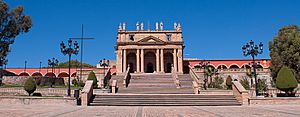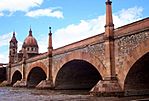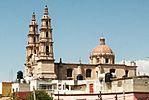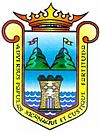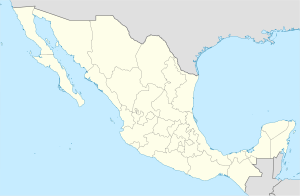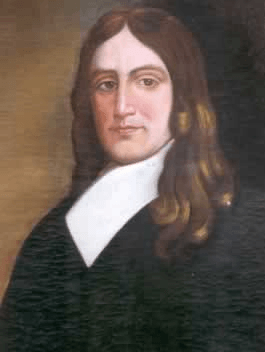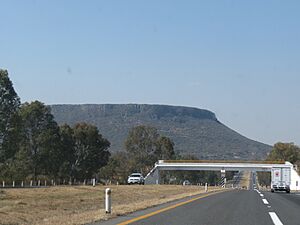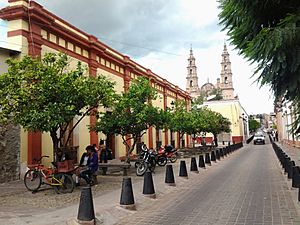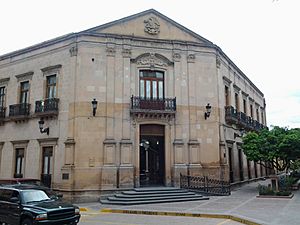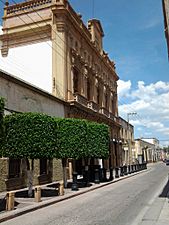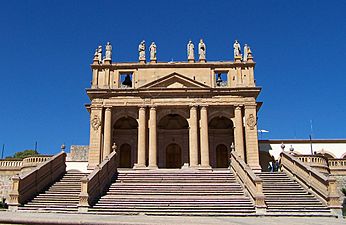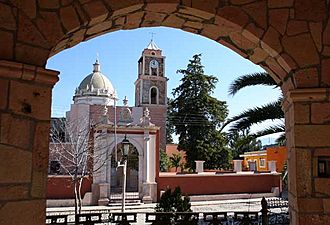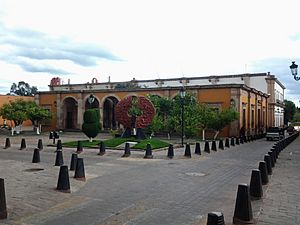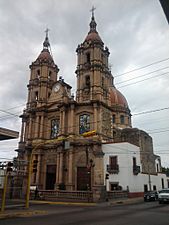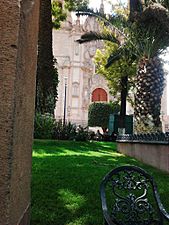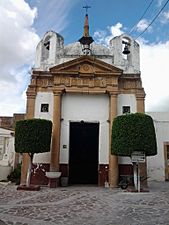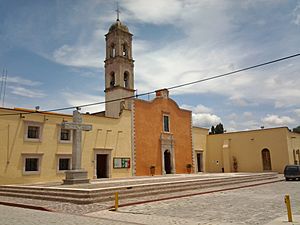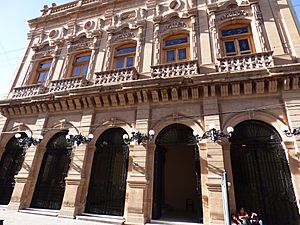Lagos de Moreno facts for kids
Quick facts for kids
Lagos de Moreno
|
||
|---|---|---|
|
Municipality and City
|
||
|
From left to right and from top to bottom: Templo del Calvario, Teatro José Rosas Moreno, Parroquia Nuestra Señora de la Asunción, Parroquia De Nuestra Señora De La Luz
|
||
|
||
| Nickname(s):
Athens of Mexico (Atenas de México)
|
||
| Motto(s):
Adversus populos Xiconaqui et Custique fortitudo
|
||
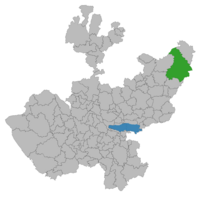
Location of the municipality in Jalisco
|
||
| Country | ||
| State | ||
| Founded | March 31, 1563 | |
| Founded as | Villa de Santa María de los Lagos | |
| Founded by | Hernando Martel and Pedro de Anda | |
| Named for | Pedro Moreno and the historical lakes in the region | |
| Area | ||
| • Municipality | 2,514 km2 (971 sq mi) | |
| • City | 24.72 km2 (9.54 sq mi) | |
| Elevation | 1,942 m (6,371 ft) | |
| Population
(2020 census)
|
||
| • Municipality | 172,403 | |
| • Density | 68.577/km2 (177.61/sq mi) | |
| • City | 111,569 | |
| • City density | 4,513.3/km2 (11,689.4/sq mi) | |
| Demonym(s) | Laguense | |
| Time zone | UTC-6 (Central Standard Time) | |
| • Summer (DST) | UTC-5 (Central Daylight Time) | |
| Area code(s) | 474 | |
Lagos de Moreno is a city and a municipality in the state of Jalisco, Mexico. It's located in a region called Los Altos de Jalisco, which is part of the larger Bajío area. This area is one of the most developed in Latin America. Lagos de Moreno is sometimes called the "Athens of Jalisco" because many famous writers and poets were born there.
The city was founded on March 31, 1563, by Hernando Martel. Its first name was Villa Santa Maria de los Lagos. This town became an important center for ranchers. By the 1600s, there were over 20,000 cattle in the area. Santa Maria grew steadily. In the 1800s, it became a city and was renamed Lagos de Moreno. This new name honored Pedro Moreno, a hero from the Mexican War of Independence.
Lagos de Moreno has a rich history and beautiful old buildings. Some of these buildings are from the 17th century. Today, it's a popular place for tourists to visit. In 2020, the city had about 111,569 people living there. This makes it the 6th largest city in Jalisco. The whole municipality, including smaller towns, had a population of 172,403.
Contents
What's in a Name?
The original name, Villa de Santa Maria de los Lagos, was given by Hernando Martel. It honored Saint Mary, the town's chosen patron saint. It also referred to the many lakes that used to be in the valley.
On April 9, 1829, the town was renamed Lagos de Moreno. This was to honor Pedro Moreno. He was a Mexican independence hero who was born in the city.
A Look Back at History
Early Times
Lagos de Moreno's history goes back a long way. It was first founded around 1028 BCE as Pechichitlán or Teziziatlan. It was once the capital of a local kingdom. In the 12th century, the Guachichiles, a group of semi-nomadic people, lived in the valley. They controlled a large area. Before the Spanish arrived, there were important ancient buildings in places like Rincón de Mesa.
Colonial Era
After the Aztec Empire fell, Spanish explorers moved into the Bajio Region. But local tribes, like the Chichimecas and Guachichiles, made it hard for them. To the east were the Guamares, and to the west were the Zacatecos. The Zacateco chiefs, Xiconaqui and Custique, fought against the Spanish from 1550 to 1590. This was part of the Chichimeca War.
Spanish settlers slowly started to build farms, called haciendas, in the area. The first Spaniard to build one in the Lagos valley was Don Diego de Ibarra. But in 1551, Chichimecas attacked his ranch. Because of these constant attacks, it was hard to settle the Lagos region for a while.
Founding the City
After many years of fighting, the Spanish decided to establish a town. The Royal Audiencia of Nueva Galicia ordered Don Hernando Martel to found a town near Pechichitan. So, on March 31, 1563, Villa de Santa María de los Lagos was officially founded. Martel worked with Father Juan de Cuenca Virues, the local priest. About 100 Spanish noble families also joined the founding.
How the City Grew
The people of Santa Maria chose the Virgin Mary as their town's special protector. They also chose Saint Sebastian. The area became very popular for ranchers. By 1600, there were around 20,000 cattle in the Lagos valley. This helped create the charreria-style rodeo, which is a traditional Mexican rodeo.
The town kept growing in the 17th century. It benefited from the good times of the Spanish Empire. In 1615, a new jail was opened. In 1621, a third church was built. Many religious buildings were constructed during this time. These included the Convent of the Poor Capuchins of Saint Joseph and the Parish Church of Our Lady of the Assumption.
Mexican Independence War
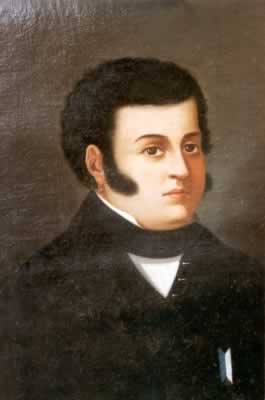
Like other parts of New Spain, Santa Maria de los Lagos saw big political changes in the early 1800s. A local lawyer, Francisco Primo de Verdad y Ramos, spoke out for Mexico's independence. Later, Father Miguel Hidalgo y Costilla, a key figure in the independence movement, visited Santa Maria de los Lagos. He held religious services and recruited families to fight against the Spanish.
From Independence to Today
| UNESCO World Heritage Site | |
|---|---|
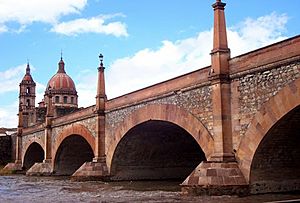
The historic Lagos Bridge with the Temple of Our Lady of the Light in the distance
|
|
| Location | Lagos de Moreno, Jalisco, Mexico |
| Criteria | ii, iv |
| Inscription | 2010 (34th Session) |
In 1823, an important agreement called the Convenio de Lagos was signed in Santa Maria. This agreement helped create the Free and Sovereign State of Jalisco. On March 27, 1824, Santa Maria officially became a city. Then, on April 9, 1829, it was renamed Lagos de Moreno. This was done to honor General Pedro Moreno, a founding father of Mexico.
Another Convenio de Lagos was signed in 1855. In this agreement, leaders recognized the Plan of Ayutla. This plan aimed to remove President Antonio López de Santa Ana from power. During the Reform War, Lagos de Moreno was controlled by different groups many times. The war ended with a victory for the liberal forces in 1861.
During the Mexican Revolution in the 1910s, people from Lagos de Moreno, like Mariano Azuela, joined the fighting. Later, in the Cristero War, a battle took place near Mesa Redonda.
In 1963, Lagos de Moreno celebrated its 400th anniversary. The city has received several important titles recently. It was named an Area of Historical Monuments in 1989. In 2010, UNESCO made it a World Heritage Site as part of the Camino Real "Tierra Adentro." In 2012, it was named a "Pueblo Mágico" (Magical Town).
Geography and Climate
Weather in Lagos de Moreno
Lagos de Moreno has a subtropical highland climate. This means it has mild temperatures all year round. Winters are mild, with an average high of about 23°C (73°F) in January. But nights can be cold, with an average low of 3°C (37°F). It doesn't rain much in winter, and there are many sunny days. It rarely freezes for long periods.
The city has two main seasons: a rainy season and a dry season. The rainy season is from June to October. July and August get the most rain. The hottest temperature ever recorded was 42°C (108°F) in March 1942. The coldest was -9°C (16°F) in January 1955.
| Climate data for Lagos de Moreno (1991–2020 normals, extremes 1942–2020) | |||||||||||||
|---|---|---|---|---|---|---|---|---|---|---|---|---|---|
| Month | Jan | Feb | Mar | Apr | May | Jun | Jul | Aug | Sep | Oct | Nov | Dec | Year |
| Record high °C (°F) | 35.5 (95.9) |
39.0 (102.2) |
42.0 (107.6) |
37.5 (99.5) |
41.5 (106.7) |
40.0 (104.0) |
36.0 (96.8) |
36.0 (96.8) |
34.5 (94.1) |
39.5 (103.1) |
34.0 (93.2) |
33.0 (91.4) |
42.0 (107.6) |
| Mean daily maximum °C (°F) | 23.5 (74.3) |
25.8 (78.4) |
28.0 (82.4) |
30.1 (86.2) |
31.2 (88.2) |
29.5 (85.1) |
27.4 (81.3) |
27.3 (81.1) |
26.8 (80.2) |
26.7 (80.1) |
25.2 (77.4) |
23.8 (74.8) |
27.1 (80.8) |
| Daily mean °C (°F) | 13.5 (56.3) |
15.2 (59.4) |
17.3 (63.1) |
19.7 (67.5) |
21.5 (70.7) |
21.9 (71.4) |
20.6 (69.1) |
20.5 (68.9) |
20.0 (68.0) |
18.4 (65.1) |
15.9 (60.6) |
13.9 (57.0) |
18.2 (64.8) |
| Mean daily minimum °C (°F) | 3.3 (37.9) |
5.1 (41.2) |
6.6 (43.9) |
9.2 (48.6) |
11.8 (53.2) |
14.3 (57.7) |
13.9 (57.0) |
13.6 (56.5) |
13.1 (55.6) |
10.0 (50.0) |
6.5 (43.7) |
3.9 (39.0) |
9.3 (48.7) |
| Record low °C (°F) | −9.0 (15.8) |
−7.5 (18.5) |
−4.5 (23.9) |
−1.0 (30.2) |
1.0 (33.8) |
3.0 (37.4) |
4.0 (39.2) |
5.0 (41.0) |
1.0 (33.8) |
−3.0 (26.6) |
−6.0 (21.2) |
−5.2 (22.6) |
−9.0 (15.8) |
| Average precipitation mm (inches) | 14.4 (0.57) |
10.7 (0.42) |
9.4 (0.37) |
9.4 (0.37) |
27.5 (1.08) |
110.8 (4.36) |
146.7 (5.78) |
118.7 (4.67) |
98.2 (3.87) |
38.5 (1.52) |
12.4 (0.49) |
10.3 (0.41) |
607.0 (23.90) |
| Average precipitation days (≥ 0.1 mm) | 1.8 | 1.2 | 1.1 | 1.3 | 4.0 | 10.5 | 13.7 | 12.2 | 10.0 | 4.5 | 1.4 | 1.3 | 63.0 |
| Average relative humidity (%) | 59 | 53 | 48 | 48 | 51 | 64 | 70 | 73 | 72 | 68 | 64 | 64 | 61 |
| Mean monthly sunshine hours | 231.3 | 240.7 | 273.5 | 282.5 | 289.9 | 230.4 | 224.8 | 223.3 | 203.2 | 241.4 | 244.8 | 214.5 | 2,900.3 |
| Source 1: Servicio Meteorológico Nacional | |||||||||||||
| Source 2: Colegio de Postgraduados (sun and humidity 1951–1980) | |||||||||||||
Land and Hills
Lagos de Moreno is located 1,942 meters (6,371 feet) above sea level. It's in the Los Altos de Jalisco region, which is part of the Bajío. The area around the city has many mountains and hills. The nearby Mesa Redonda is a very noticeable hill.
Plants and Animals
The Mesa Redonda is home to many unique plants. Two types of cactus grow there that are found only in Jalisco. One of these types is found only on the steep slopes of Mesa Redonda. This helps protect it from animals.
Many animals live in the Lagos valley. You can find hares, rabbits, deer, and boars. People who live on nearby ranches have also seen coyotes and snakes in the countryside. Locals often gather vegetables from nature in areas like Mesa Redonda, especially prickly pear cacti.
People of Lagos de Moreno
In 2020, the city of Lagos de Moreno had 111,569 people. This makes it the 6th largest city in Jalisco. The entire municipality had about 172,403 people. There are slightly more females than males in the municipality.
Famous People from Lagos
Sports Stars
- Luis Fernando Macias: A professional cyclist who won a silver medal in 2009.
- Armando Reynoso Gutiérrez: A baseball player for the Mexican national team. He is in the Mexican Baseball Hall of Fame.
- Isaác Brizuela Muñoz: A Mexican-American soccer player for C.D. Guadalajara.
- Carmelo Reyes González: A famous former professional wrestler.
Artists and Writers
- Lola Álvarez Bravo: A well-known photographer. She was important in the art world after the Mexican Revolution.
- Juan Pablo Villalobos: An author and business person.
- José Rosas Moreno: A writer, fable writer, and poet from the 1800s.
- Mariano Azuela González: A writer and critic from the late 1800s and early 1900s.
Religious Figures
- Juan Manuel Martín del Campo: A Catholic priest and exorcist. He was given the title of Venerable by Pope Francis.
Gallery
Getting Around
The city used to have its own airport, the Francisco Primo de Verdad National Airport. Now, the closest airport is Del Bajío International Airport (IATA: 'BJX). It's located near Silao, Guanajuato, about an hour's drive away.
See also
 In Spanish: Lagos de Moreno para niños
In Spanish: Lagos de Moreno para niños


